Microsoft Surface Pro 3 Review
by Anand Lal Shimpi on June 23, 2014 3:55 AM ESTThickness, Thermals and Core: Understanding how Surface Pro 3 Got so Thin
Ever since Surface RT showed up I've wanted Surface Pro but in the RT chassis. Microsoft seemed to consciously avoid any lower TDP Core processors in favor of Ultrabook SKUs, which pretty much kept Surface Pro thicker than its ARM-based counterpart. Surface Pro 3 changes everything with a rethinking of how Microsoft embraced the thermal constraints of a tablet.
Surface Pro 3 is available with one of three CPU options: a Core i3, Core i5 or Core i7. The latter two are 15W TDP parts, while the former is a 11.5W TDP/6W SDP Haswell Y SKU. Haswell Y is really designed for passively cooled form factors, but all three CPU options receive the same heatpipe and fan cooling system offered by the Surface Pro 3. In short, the Core i3 model should behave a lot more like a standard Ultrabook part (sans Turbo).

Surface Pro 2 (left) vs. Surface Pro 3 (right)

Apple iPad Air (left) vs. Surface Pro 3 (right)
Microsoft's claim to fame is the ability to build the world's thinnest device with a Core series CPU inside. At 9.1mm thick, the Surface Pro 3 is just barely thicker than last year's Surface 2 but with a full blown dual-core Haswell instead instead of a high-end phone/tablet ARM SoC. As both the Surface Pro 2 and Surface Pro 3 used 15W Haswell Ultrabook parts and Microsoft claims a performance increase over last year's model, the question is how Microsoft can reduce thickness, keep TDP the same and increase performance. The answer is simply a difference in what's acceptable from a thermal standpoint.
Here's a look at the original Surface Pro while running an hour long loop of 3DMark Ice Storm Unlimited. I chose this test in particular as it behaves as a nice balance between CPU and GPU workloads on the device:
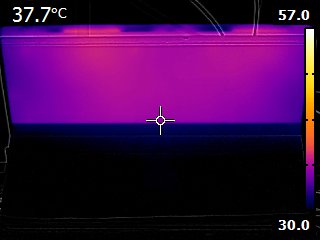
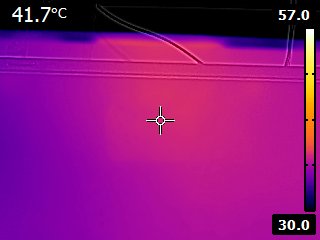
You can almost trace out the path of the heat pipe carrying the thermal load away from the CPU and to the two fans in the system. I measured peak temperature here at 41.7C.
Now let's look at Surface Pro 2:
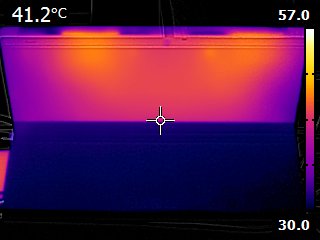
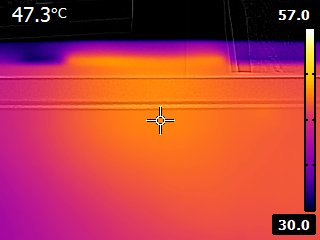
Despite a move to Haswell, Microsoft lets the device get much warmer. You can make out the same U-shape thermal distribution as heat is carried away using the two fans, but the temperatures are much higher. I measured a maximum temperature running the same workload of 47.3C.
Here we have Surface Pro 3:
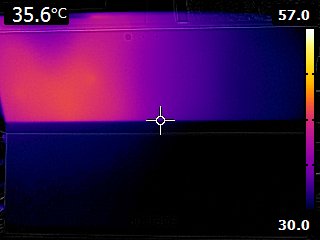
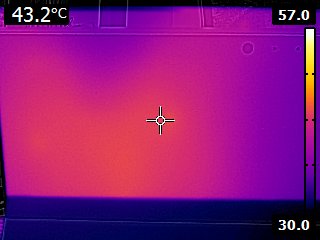
Right away you can see the new cooling system at work. The thermal load is mostly confined to the left side of the image (we are looking at the back with the kickstand unfolded towards the camera, so if you were looking at the display we're talking about the upper right side of the machine). The cooling solution is far more compact and I suspect ready for a move to Core M (Broadwell). Peak temps however are much closer to Surface Pro 1 at 43.2C.
The thermal story points us in the right direction. Either Surface Pro 3's fan and heatpipe configuration is able to remove heat far better than Surface Pro 2's design could, or the CPU in SP2 doesn't get as warm. I suspect it's the latter.
For starters, I'm guessing that Intel is helping Microsoft with delivering better binned Haswell ULT and Y series SKUs. But the big change is I believe Microsoft is more aggressive about reducing CPU and GPU frequencies in Surface Pro 3 compared to Surface Pro 2. Benchmarks will show an increase in performance due to more aggressive ramping up/down of clock speeds vs. Surface Pro 2, but prolonged load cases will likely show a decrease in performance vs. last year's model.
I first stumbled upon this behavior while trying to gather thermal data for Surface Pro 3. I noticed large run to run variance if I repeatedly ran 3DMark 11. I'm used to seeing this sort of behavior on smartphones that throttle quickly, but it was unique for a Surface Pro device.
3DMark is a synthetic test so the real question was how would Surface Pro 3 perform in a real world scenario where sustained CPU/GPU load was guaranteed for a long period of time. I figured a game playable on the machine like Dota 2 would be a great example. I asked our own Ryan Smith to whip up a custom benchmark using the game and I ran it on Surface Pro 1, 2, 3 as well as a 13-inch MacBook Air (Early 2014). The graph below illustrates average frame rate during our Dota 2 benchmark for all of the systems:
As you can see, even with Surface Pro 3's fan running the platform doesn't deliver sustained performance equal to last year's model. It's an understandable tradeoff given the substantial reduction in device thickness (and thus improvement in usability), but it's important to note nonetheless.
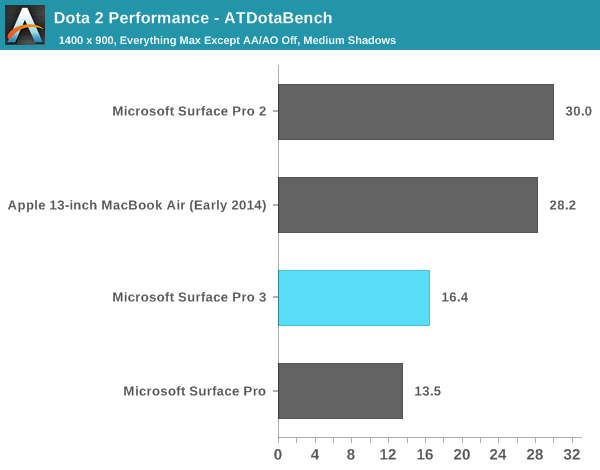
Workloads that are CPU and GPU heavy are one thing, but what about sustained productivity workloads? Penny Arcade's insanely talented artist Gabe mentioned that he noticed substantial lag when drawing on his Surface Pro 3. As Surface Pro 3's NTrig pen is actually lower latency than Surface Pro 2's, I wonder if what Gabe ran into might be thermal related rather than pen related (alternatively it could have to do with the much higher display resolution that Surface Pro 3 runs at). I needed a repeatable workload to see if non-gaming use cases also showed a regression. Thankfully PCMark 8 v2 provides a number of relatively long, repeatable workloads that are great for testing just this.
I decided to use the PCMark 8 v2 Work suite which includes web browsing, office producitivity (word processing and spreadsheet work) and video chat. It's a far cry from a Cinebench loop but I figured if I saw throttling here it would easily be present in heavier workloads. Each run of the suite actually repeats the tests three times and takes around 20 minutes to complete on the Surface devices. I measured performance for three suite runs (9 total runs of the Work loop) on both Surface Pro 2 and 3:
| PCMark 8 v2 Work Performance Over Time | |||||||
| Work Suite Run #1 | Work Suite Run #2 | Work Suite Run #3 | |||||
| Microsoft Surface Pro 3 (Core i5) | 3273 | 3031 (92% of peak) | 3129 (95% of peak) | ||||
| Microsoft Surface Pro 2 (Core i5) | 3222 | 3223 | 3218 | ||||
As you can see, there's a 9% drop in performance on Surface Pro 3 from the first suite run to the next while Surface Pro 2 delivers consistent performance between runs. By the third run Surface Pro 3's performance recovers a bit, although it's still a few percent below the initial, cool run.
PCMark 8 v2 also plots CPU temperature and frequency throughout the course of the benchmark. Unfortunately I don't think I can export the data so I'm forced to present screenshots from the benchmark harness itself. Thankfully even looking at these screenshots is enough to tell us what's going on between the two Surface Pro devices:
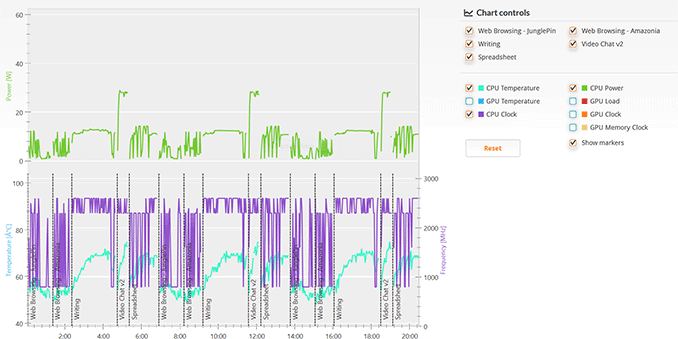
Surface Pro 2 PCMark 8 v2 Work Suite
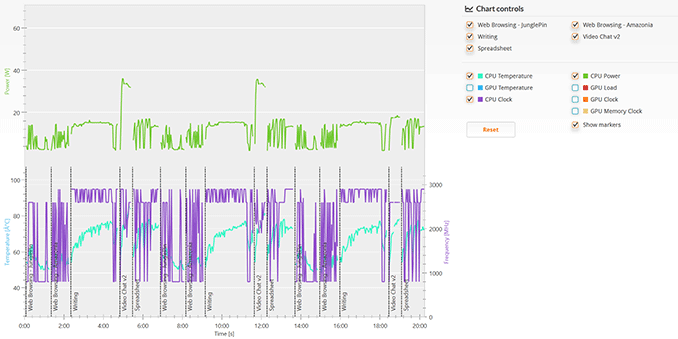
Surface Pro 3 PCMark 8 v2 Work Suite
Both devices do a good job of reaching max turbo fairly regularly, but Surface Pro 2 appears to spend more time at its max turbo state. By the last loop of the benchmark Surface Pro 3's max power is limited (green line) by the time we get to the video chat workload, I suspect that is where we lose a bit of performance. I'm only looking at the last of three suite runs here, if we looked at the second one the results would be even worse.
I haven't tested Surface Pro 3 in Microsoft's new docking station so I don't know if the device changes its thermal profile at all when docked, but in tablet or laptop mode it's definitely going to throttle quicker than Surface Pro 2 did. I must stress that I don't think this is necessarily a bad idea. Surface Pro 3 improves usability over Surface Pro 2 by leaps and bounds, and it's still faster under load than the original Surface Pro. All of this comes at the expense of reduced sustained performance. As you'll see from the rest of our tests, peak performance did get better over last year's model.
Fan Noise
Surface Pro 3's single fan is more noticeable than in Surface Pro 2. The sound it produces isn't necessarily louder, and when spinning it sounds a lot like any other Ultrabook with a fan in it. Compared to Surface Pro 2, the fan does kick in more frequently. For light tablet workloads or even light office work on Surface Pro 3, the fan remains silent. It's only when you're doing anything CPU or GPU intensive that you'll hear it spin up. The big difference is that in situations where you wouldn't hear fans spinning on Surface Pro 2, you'll sometimes hear it on SP3. This is the tradeoff that comes with the thinner chassis.










274 Comments
View All Comments
anandbiatch - Monday, June 30, 2014 - link
Don't forget that it can also replace your desktop.Why buy 3 devices when Surface 3 is perfect.
mkozakewich - Monday, June 30, 2014 - link
Or better yet, you're like me, and you saved on whatever a good tablet is worth by not having another tablet at all.It's always seemed a bit superfluous to me, like you just need a phone with a bigger screen sometimes. (Or in this case, a laptop that can fold up flat.)
Gunbuster - Monday, June 23, 2014 - link
Oh give it up and please point out a product that covers all the bases the SP3 does and is better. If you want a tablet get an ipad or a cheap $100 android. If you want a bad-ass laptop get a 6 pound alienware or a $3000 ultra-book. (Now lug around both of those) If you want a very portable convertible with pen input and detachable keyboard you get this. It is the best at what it was designed for. All compromise? Hardly.TEAMSWITCHER - Monday, June 23, 2014 - link
Did you read the article? I don't think the SP3 "covers" any bases, it merely "touches" them.PC fan boys may have found their MacBook Pro and iPad Air killer, but in general, Windows consumers are not conditioned to the premium pricing. Without a lower cost version of the same thing, there will be no mass adoption, sparking the next great wave Windows applications. This is a niche product.
Gunbuster - Monday, June 23, 2014 - link
What exactly are you arguing? Is it "all compromises" or "expensive"?TEAMSWITCHER - Tuesday, June 24, 2014 - link
It's not all compromises - but there are some. And yes it's as expensive as Apple gear. More so if you consider OS X updates are free. Will Windows 9 be free? I highly doubt that it will.PaulC543 - Tuesday, June 24, 2014 - link
Of course there are come compromises, please show us a laptop or tablet which has none. There aren't any.As for it being as expensive as Apple gear, true, and it has every bit the material/build/design quality as Apple gear, has several superior specs - screen quality/resolution, pen, and it saves you from having to buy two devices if you want both laptop/desktop level performance AND a tablet form factor.
Will Windows 9 be free? Probably not, but even if it's the typical $100 upgrade, spread over a 3 year version cycle that's about $30 a year. And even if you never upgrade the OS, Microsoft will support it with updates for 10+ years - far longer than you're likely to be using the Surface.
You're grasping at straws and your arguments are tired and desperate.
TEAMSWITCHER - Tuesday, June 24, 2014 - link
Oh come on. If Apple had created the Surface Pro 3 there would no end to the insults sprayed toward the Mac faithful for the cost (having to buy the keyboard separately)...the term "lapability" (or lack there of) ... the colors (pink? really?).I think its kind of fun to see the MS faithful strain themselves against a few well pointed concerns. Welcome to the premium device life...where you spend a lot of money for the little extras. Hopefully this will inspire some understanding for the Mac faithful...and vice versa.
PaulC543 - Wednesday, June 25, 2014 - link
"I think its kind of fun to see the MS faithful strain themselves against a few well pointed concerns"I'll totally agree that the prices of accessories is excessive. The keyboard covers should cost maybe $40/$60 each for touch/type, and even that would be pushing it. Most docks are in the $160-$200 range, so the Surface one isn't outrageous, but for that price, it should include a few extra ports.
But let's be honest, the cost of accessories is not what the Surface is primarily criticized for. It's criticized for being a utterly failed laptop, which it's not. It's criticized for being an utterly failed tablet, which it's not. It's criticized for being good at absolutely nothing, and by and large, all these criticisms come from people who've never actually touched one.
If Apple made the surface? You can't be serious. If Apple made the Surface, the tech-press would have fawned all over themselves to praise the hybrid form factor, defended the value of the device at any price, and declared the PC was clearly doomed in the face of Apple's demonstrated unending genius.
mkozakewich - Monday, June 30, 2014 - link
Actually, the tech press has shown themselves to be pretty obstinate in the face of dramatic technological upheaval. Look for some reviews of the original iPad, back when the idea of having 'a tablet' meant one of those really stupid inch-thick convertible HP notebooks with a trimmed-down version of Windows XP.Even the iPhone got lukewarm press, from what I remember. There were lots of complaints about the lack of 3G and the terrible reception from AT&T. There were also no applications for it.
In the end, if tech journalists are bashing something that doesn't fit into a specific category, I'd watch that very carefully and make my own decisions, because it's likely something new and wonderful.